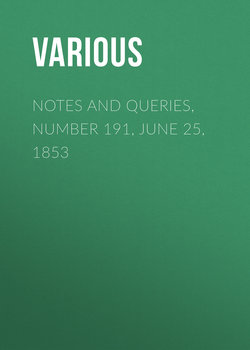Читать книгу Notes and Queries, Number 191, June 25, 1853 - Various - Страница 2
Notes
"EMBLEMATA HORATIANA."
ОглавлениеWhatever may be proposed as to republishing works of English emblems, the work published in Holland with the above title at all events deserves to be better known. All the English works on the subject I ever saw, are poor indeed compared with the above: indeed, I think most books of emblems are either grounded or compiled from this interesting work; which is to the artist a work of the deepest interest, since all the designs are by Otho Venius, the master of Rubens. Not only are the morals conveyed lofty and sound, but the figures are first-rate specimens of drawing. I believe it is this work that Malone says Sir Joshua Reynolds learned to draw from: and if he really did, he could have had nothing better, whatever age he might be. "His principal fund of imitation," says Malone, "was Jacob Cat's book of emblems, which his great-grandmother, by his father's side, who was a Dutch woman, had brought with her from Holland." There is a small copy I think published in England, but a very poor one: the original work, of which I possess a portion only, is large, and engraved with great care. And I have often thought it a pity such an admirable work should be so scarce and little known. Whoever did it, it must have occupied many years, in those slow days, to make the designs and engrave them. At the present day lithography, or some of the easy modes of engraving, would soon multiply it. The size of the engravings are rather more than seven inches. Many of the figures have been used repeatedly by Rubens, and also some of the compositions. And though he is certainly a better painter, he falls far short in originality compared with his master; and, I may add, in richness of material. I should say his chief works are to be found in that book. One of my leaves is numbered 195: so I should judge the work to be very large, and to embrace a variety of subjects. Some of the figures are worthy of Raffaelle. I may instance one called the "Balance of Friendship." Two young men have a balance between them; one side is filled with feathers, and the other with weightier offerings: the meaning being, we should not allow favours and gifts to come all from one side. The figures have their hands joined, and appear to be in argument: their ample drapery is worthy of a study for apostles.
"Undertake nothing beyond your Strength" is emblemised by the giants scaling the heavens: one very fine figure, full of action, in the centre, is most admirably drawn.
"Education and Habit" is another, full of meaning. Two dogs are running: one after game, and another to a porringer. Some one has translated the verses at the bottom on the back of the print as follows. This has a fine group of figures in it:
"When taught by man, the hound pursues
The panting stag o'er hill and fell,
With steadfast eyes he keeps in view
The noble game he loves so well.
A mongrel coward slinks away,
The buck, the chase, ne'er warms his soul;
No huntsman's cheer can make him stay,
He runs to nothing, but his porridge bowl.
Throughout the race of men, 'tis still the same,
And all pursue a different kind of game.
Taverns and wine will form the tastes of some,
Others success in maids or wives undone.
To solid good, the wise pursues his way;
Nor for low pleasure ever deigns to stay.
Though in thy chamber all the live-long day,
In studious mood, you pass the hours away;
Or though you pace the noisy streets alone,
And silent watch day's burning orb go down;
Nature to thee displays her honest page:
Read there—and see the follies of an age."
The taste for emblemata appears to have passed by, but a good selection would be I think received with favour; particularly if access could be obtained to a good collection. And I should like to see any addition to the Rev. J. Corser's list in the Number of the 14th of May.
Weld Taylor.
